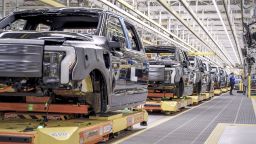Ford (F) said it will lose $3 billion on its sales of electric vehicles to consumers this year, but it still expects to hit the profit targets it set for this year of between $9 billion and $11 billion.
Ford said those EV losses and the overall profit both come before expenses from interest and taxes. The $3 billion loss is roughly equal to what it lost on EVs on that basis the last two years combined. It said it lost about $900 million in 2021 and $2.1 billion in 2022. It’s the first time it gave a breakout of the results from its EV operations.
But it said it still expects EVs to start making money soon, going from a 40% operating loss margin last year, when it sold about 96,000 EVs, bringing in $5.3 billion in revenue, to about an 8% profit margin by the end of 2026. It expects increased production of EVs to bring global product of those vehicles to a 2 million annual rate by the end of that year.
Even if Ford hits its profit margin goals for the EV business, it’ll still be far less profitable than what’s been reported at EV leader Tesla. It reported a 22% profit margin in the fourth quarter, again excluding the cost of interest and taxes as well as depreciation and amortization. While it’s not an exact comparison to the profit margins reported by Ford and other long-time automakers, it is an indication that Tesla has a wide lead in making a profit selling EVs, while legacy automakers struggle to make a profit on electric cars.
But when questioned during an investor conference call Thursday whether or not Ford would be able to hit its EV profit goals, John Lawler, Ford’s CFO, said the company is confident with its projection, partly because of the number of Tesla alumni it has been able to hire away.
“Look, it’s about the talent we have,” Lawler said. “We all know there’s one profitable EV manufacturer. The folks that designed those vehicles are at Ford. It’s a whole new way of how we’re designing vehicles, very much focused on energy efficiency…. And we have the people at Ford that know how to do that.”
Ford cut the price of one of its EVs, the Mustang Mach E, earlier this year when it raised production of those vehicles, and Tesla has also cut the price of its lower-priced models in various markets around the world.
While both the Mach E and the F-150 Lightning EV pickup have a long list of waiting customers, Ford CEO Jim Farley said during an earnings call earlier this year that Ford encountered numerous problems with their production, making the ramp up of EVs much more expensive than it had anticipated.
“We didn’t know that our wiring harness for Mach-E was 1.6 kilometers longer than it needed to be. We didn’t know it’s 70 pounds heavier and that that’s [cost an extra] $300 a battery,” he said on a call with investors. “We didn’t know that we underinvested in braking technology to save on the battery size.”
Farley said these and other cost problems meant that Ford “left about $2 billion of profit on the table.”
Ford, which will be meeting with investors later Thursday, released financial data on EVs early Thursday that will be shown as part of that presentation.
The presentation will detail how Ford will report results going forward, no longer breaking out profits and losses by geographic region but by product line instead.
“Ford Blue” is the segment for consumer vehicles with internal combustion engines (ICE) and hybrid vehicles, “Ford Model e” is the segment for EVs, and Ford Pro for commercial vehicles, including both ICE and EVs.
Last year it had earnings before interest and taxes of $6.8 billion from Ford Blue, $3.2 billion from Ford Pro, in addition to $2.7 billion from Ford Credit, which covered the losses from last year. It expects to make about $7 billion from Ford Blue and $6 billion from Ford Pro this year, although profits from Ford Credit are expected to fall by about 50% to $1.3 billion.


























